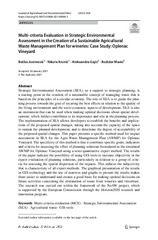Приказ основних података о документу
Multi‑criteria Evaluation in Strategic Environmental Assessment in the Creation of a Sustainable Agricultural Waste Management Plan for wineries: Case Study: Oplenac Vineyard
| dc.creator | Josimović, Boško | |
| dc.creator | Krunić, Nikola | |
| dc.creator | Gajić, Aleksandra | |
| dc.creator | Manić, Božidar | |
| dc.date.accessioned | 2021-03-22T10:16:38Z | |
| dc.date.available | 2021-03-22T10:16:38Z | |
| dc.date.issued | 2021 | |
| dc.identifier.issn | 1187-7863 | |
| dc.identifier.uri | https://raumplan.iaus.ac.rs/handle/123456789/609 | |
| dc.description.abstract | Strategic Environmental Assessment (SEA), as a support to strategic planning, is a starting point in the creation of a sustainable concept of managing waste that is based on the principles of a circular economy. The role of SEA is to guide the planning process towards the goal of securing the best e ects in relation to the quality of the living environment and the socio-economic aspects of development. SEA is also an instrument that can be used when making optimal decisions about spatial development, which further contributes to its importance and role in the planning process. The implementation of SEA allows developers to establish the bene ts and implications of the proposed spatial changes, taking into account the capacity of the space to sustain the planned development, and to determine the degree of acceptability of the proposed spatial changes. This paper presents a speci c method used for impact assessment in SEA for the Agro-Waste Management Plan (AWMP) for Oplenac Vineyard. The speci city of this method is that it combines speci c goals, indicators and criteria for assessing the e ect of planning solutions formulated in the simulated AWMP for Oplenac Vineyard using a semi-quantitative expert method. The results of the paper indicate the possibility of using GIS tools to increase objectivity in the expert evaluation of planning solutions, particularly in relation to a group of criteria for assessing the spatial dispersion of the impacts. This reduces the subjectivity that is characteristic of all expert methods. The graphical presentation of the results in GIS technology and the use of matrices and graphs to present the results makes them easier to understand and creates a good basis for making optimal decisions on future activities concerning the elimination of waste from wineries and viticulture. The research was carried out within the framework of the NoAW project, which is supported by the European Commission through the Horizon2020 research and innovation program. | sr |
| dc.language.iso | en | sr |
| dc.relation | info:eu-repo/grantAgreement/EC/H2020/688338/EU// | sr |
| dc.relation | info:eu-repo/grantAgreement/MESTD/Technological Development (TD or TR)/36035/RS// | sr |
| dc.relation | info:eu-repo/grantAgreement/MESTD/Technological Development (TD or TR)/36036/RS// | sr |
| dc.rights | openAccess | sr |
| dc.rights.uri | https://creativecommons.org/licenses/by/4.0/ | |
| dc.source | Vol.:(0123456789) Journal of Agricultural and Environmental Ethics | sr |
| dc.subject | Multi-criteria evaluation (MCE) | sr |
| dc.subject | Strategic Environmental Assessment (SEA) | sr |
| dc.subject | Agricultural waste | sr |
| dc.subject | GIS tools | sr |
| dc.title | Multi‑criteria Evaluation in Strategic Environmental Assessment in the Creation of a Sustainable Agricultural Waste Management Plan for wineries: Case Study: Oplenac Vineyard | sr |
| dc.type | article | sr |
| dc.rights.license | BY | sr |
| dcterms.abstract | Јосимовић, Бошко; Крунић, Никола; Гајић, Aлександра; Манић, Божидар; | |
| dc.citation.volume | 34 | |
| dc.citation.issue | 1 | |
| dc.citation.spage | 4 | |
| dc.citation.rank | M21 | |
| dc.identifier.doi | 10.1007/s10806-021-09846-3 | |
| dc.identifier.scopus | 2-s2.0-85101576586 | |
| dc.identifier.fulltext | https://raumplan.iaus.ac.rs/bitstream/id/2595/Josimovic&al-2021-Journal_of_Agricultural_and_Environmental_Ethics.pdf | |
| dc.type.version | publishedVersion | sr |

